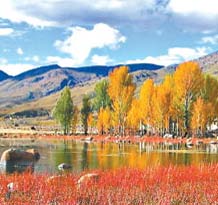
Southeast of Qinghai-Tibet Plateau, and east of the Hengduan Mountain lies a hideaway where visitors can escape the hot summer. Now known worldwide, Daocheng is considered another Shangri-la hidden within the mountains in southwest China.
Daocheng, subordinate to the Ganzi Tibetan Autonomous Prefecture, is special with its geographical features and natural scenery. The area is enveloped by waterfalls, thick forests, snow-capped mountains, made further unique by the Tibetan culture of the people.
The temperature in summer averages 24 degrees, much cooler than nearby cities Chengdu or Kunming.
There are 1,145 lakes scattered in an area of 3,200 square kilometers.
Western Sichuan's Yading Nature Reserve in Daocheng County is undoubtedly one of China's most awe-inspiring nature reserves.
It is regarded as a sacred area by Tibetans. Every stunning vista here is celebrated with traditional small prayer flags or mani stones.
On this adventure, you will discover Tibetan small towns reminiscent of the wild west, rolling landscapes plumed with wheat and barley fields, and the spectacular natural beauty of Yading Nature Reserves snowcapped mountain peaks.
Thirteen monasteries make this area their home. Xiongden and Gonggaling Monasteries are the best known. Grandly constructed, Gonggaling Monastery has in its possession a bronze statue of Maitreya presented by the Dalai Lama V.
Chengdu, the capital city of southwest China's Sichuan Province, is the first port-of-call if you arrive by plane. Flights cost 900 yuan (US$108) for the 1.5 hour journey. By train, the fee will change depending on the route taken. Generally, it will cost 300 yuan (US$36) to 420 yuan (US$50) for a sleeping berth and take between 24 to 36 hours.
If time is available, try following this 7 day itinerary:
Day 1: Chengdu-Kangding
There are bus routes to Kangding near the airport and Chengdu Railway Station in every half hour.
Kangding, a former outpost on the trade route to Tibet, is a large city tucked around a river valley. The sidewalks of Kangding are filled with Hui Minority members, Chinese Muslims, and Tibetans who have come from the highlands to sell wild mushrooms, vegetables, yak skins and various paraphernalia.
Day 2: Kangding-Litang
Wake up early to to explore this picturesque remote Tibetan town.
At an altitude of just over 4,000 meters, this is one of the highest towns in the world.
This small town is great for passing time, watching people and strolling around. The monastery is now home to more than 1,000 Yellow Hat sect monks.
The trip from Kangding to Litang could take five to six hours.
Day 3: Litang-Daocheng-Yading
Yading nature reserve is home to three sacred Tibetan mountains: Chenresig (Avalokitesvara, 6,032 meters), Jambeyang (Manjusri, 5,958 meters), and Chanadorje (Vajrapani, 5,958 meters), representing compassion, wisdom, and energy.
Tibetan Buddhists believe that making a kora (pilgrimage) around these mountains brings great peace.
The drive from Litang to Daocheng will take approximately four hours (180 km), and the trip from Daocheng to Yading (60 km) will take approximately 3 hours as much of the road to the park is dirt track.
Day 4: Hiking and horse riding in Yading
From the reserve entrance, you will traverse a beautiful wooded pathway leading to a valley set at the foot of the spectacular Chanadorje Mountain.
The incredible scenery in Yading Nature reserve is worth more than a daily visit.
Day 5: Yading-Daocheng
There are many more monasteries and friendly Tibetan families to meet, and small hiking trips to take on this peaceful, serene journey.
Day 6: Daocheng-Xiangcheng-Zhongdian
This long but scenic drive to Zhongdian will take you past Ganden Sumsanlin monastery, the largest monastery in Yunnan, built in the 17th century. This impressive commune was established under the instruction of the Dalai Lama V, and is now home to over 700 monks.
If time permits, visit Shangri-La, 250 km from Zhongdian. In Kunming, flights for around 1,000 yuan (US$125) are available for the return trip to Beijing.
(Beijing Weekend August 20, 2004)
|

